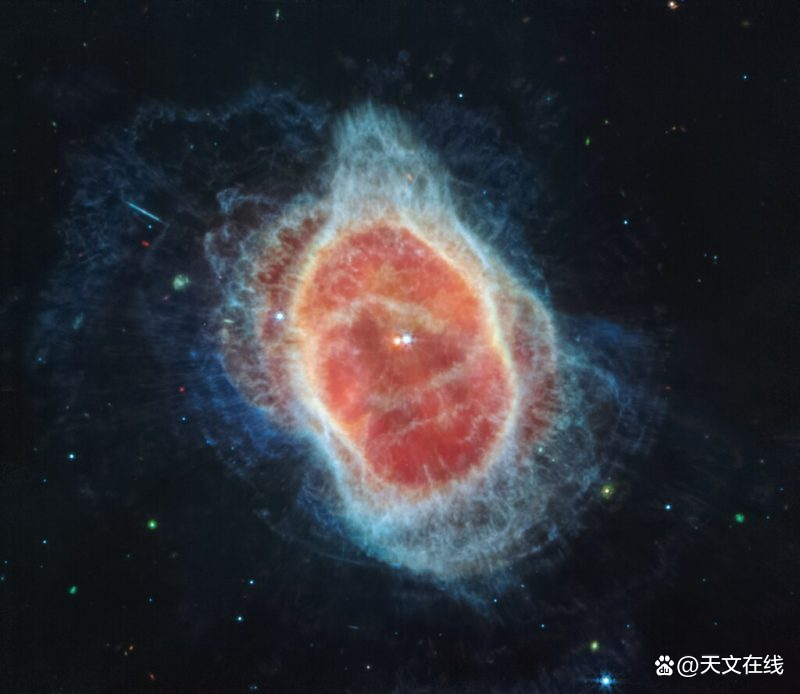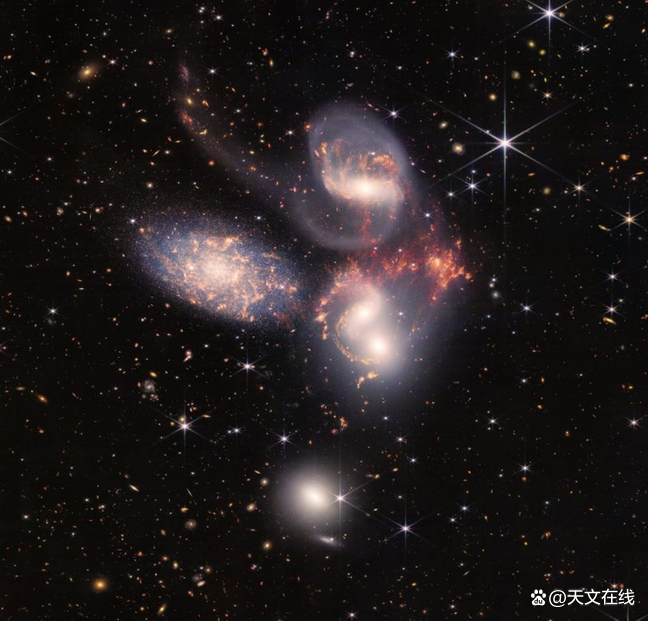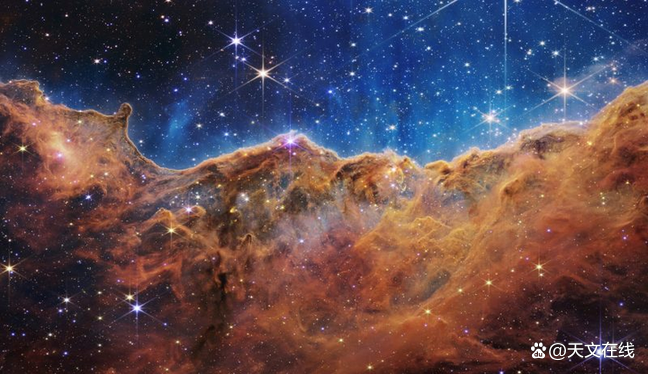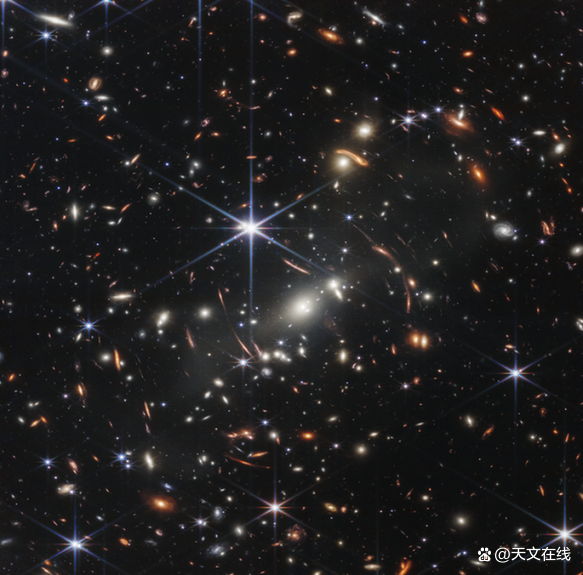I ca n’t tire of it, it is unprecedented, this is the 4 most beautiful cosmic map taken by Weber
Author:Astronomy online Time:2022.07.23
The National Aeronautics and Space Agency (NASA) and the European Aviation Administration (ESA) and the Canada Astronomy (CSA) have announced the huge number of James Weber Space Telescopes at a online conference on July 12, 2022. a photo. The next day, on July 13, 2022, there were other four other photos taken by Weber telescope.
Let's take a look together!
1. South Ring Ring Nebula (Southern Ring Nebula)
The southern ring nebula is also known as the "eight -character nebula", which is a planetary nebula. In other words, it is an expansion structure that surrounds a small -quality star that is about to die, and the expansion structure formed. Its diameter is about half a light years, and the distance between the earth is about 2000 light years.

In the background of the dark universe, the planetary nebula shot by the James Weber Space Telescope (Miri) and the light spots generated by the stars behind the nebula. In this ellipse -shaped nebula, the bright blue gases of the stocks are sprayed out of radiation from the middle of the nebula. Inside the sparse blue gas cloud, there are two independent light red oval gases stacking each other. In the center of Nebula, there are two stars close to each other, one of which looks more red, while the other looks more yellow. The picture comes from: NASA, ESA, CSA and STSCI.
2. Stephan ’s Quintet
Stephen's five -star galaxy is located in the horse about 29 million light years away from the earth. In 1877, people observed this deck of Micro -galaxy, and it was also known as the first tortoise group discovered by humans. Of these five galaxies, four of them were locked in the "dance" of the cosmic scale, constantly contacting close contact with the surrounding galaxies, and reciprocating.

This picture shows the five galaxies closer to each other in the sky: two are in the middle, one is above, one is facing up to the left, and the other is at the bottom. Of these five galaxies, four seem to be in contact with each other, and the other seems to be isolated. In the picture, these five galaxies are very huge compared to the more distant galaxies in the background. They all contain bright white nuclear balls, but their size, shapes, structures and colors are small. Those who are located in front of the galaxy, all over the entire picture, have eight bright white light spots with eight bright radiant star mangers, are images formed by stars with galaxy prospects under the derivative of instruments. The picture comes from: NASA, ESA, CSA, and STSCI.
3. Carina Nebula
The nebula on the bottom of the ship is one of the largest and brightest nebula in the night sky. It is located on the south side of the ship, about 7,600 light years from the earth. Nebula is the first place formed by the stars, and the nebula at the bottom of the ship is a place where the star is many times larger than our sun.

The base cloud picture taken by Weber telescope is divided into two parts: a horizontal wave -shaped line, which is distributed in the upper and lower parts. Below is a nebula distribution, which is relatively blurry image, and the upper above is relatively clear. In these two backgrounds, we can see the starry sky with many stars of different sizes. In the starry sky, the smallest stars are also very small and far away in the picture, just emitting faint light; and the largest stars look larger and closer, making it easier for people to distinguish its eight diffraction stars mango Essence The part of the picture is a bit blue, and there are some translucent and slim stripes from the nebula below. The lower half of the picture shows the distribution of orange nebula. Different positions have different density, from transparent to opaque. The stars also show different colors, but the color of most stars is blue or orange. The cloud -like structure of the nebula contains ridges, peaks and valleys, which are very similar to the mountains on the earth. The three diffraction stars emitted from the upper right edge of the picture suggest that there is a large star existence outside the field of view of this picture. The picture comes from: NASA, ESA, CSA, and STSCI.
4. WASP-96 B (spectral chart)
WASP-96 B is a giant planet outside the solar system and is mainly composed of gas. The planet is nearly 1150 light years from the earth, 3.4 Earth Days of the cycle of the rotation of its mother star. Its quality is about half of Jupiter, and people observe it for the first time in 2014.

The title of this picture is called "The hot-outer giant giant stars WASP-96 B's atmosphere, Niriss's single target seamless spectrometer". This picture shows that the NIRISS single target seamless spectrometer of the Weber telescope is captured. When the planet WASP-96 B passes through the in front of the mother star, the transmission spectrum of its atmosphere, and an art imagination of the artistic imagination of the planet from the front of the mother star picture. In the diagram of the data point, the degree of light blocking is drawn with a vertical axis. The unit is one -millionth; the wavelength of the horizontal axis is light, and the unit is micron. The blue curve drawn on the picture represents the best model with data matching. In this picture, the data shows four outstanding peaks, which are marked as "water, H2O" based on the data of the model. The picture comes from: NASA, ESA, CSA, and Stsci.5.SMACS 0723: The image first announced on Monday this Monday
NASA and cooperation agencies announced the first photo of the Weber telescope at a special conference at the White House on Monday (July 11, 2022). This picture shows a star group that is 4.6 billion light years away from us, named SMAC 0723 (this star group is a fuzzy object in the center of the photo center). This huge star group plays a role of gravitational lens, which enlarges the more distant galaxy behind it, so that they can be seen by us. Thousands of galaxies appear in this photo of the Weber telescope, so this photo is also known as Weber's first deep -field image.
In the first picture of the James Weber space telescope, this telescope shot a small slice of the vast universe. What we see in this photo is about the size of a grain of sand that is far away from our arms on the sky. This picture consumes only 12.5 hours of shooting time, but it has reached a deeper position than the deep photos taken by Hubble telescope for a few weeks. The picture comes from webb.

6. Continue to follow us
NASA invited you to continue to pay attention to the task of Weber Space Telescope, and through Twitter, Facebook, and Instagram, the topic #UnfoldtheUniverse shared his first photo with Weber. You can pay attention to these accounts to get more information:
The following is a list of the future data release plan (all time is the eastern time in the United States)
On Tuesday, July 12, 2022, the data release event began at 10:30 Eastern Time in the United States
The official picture announcement event -the announcement of the picture will be reported on the live broadcast, which can be watched on the official website of NASA TV, NASA clients and NASA. The public can also watch the live broadcast on Facebook, Twitter, oil pipe, Twitch and Daily Motion.
NASA Social (NASA's social media account): NASA hosted a live NASA social event on Tuesday, July 12. As a guest, the participants participated in the shooting room shooting at the TV broadcasting room at NASA Goda Space Flying Center, visited the facilities of NASA Goddard Space Flying Center and Space Telescope Research Institute, and interacted with the experts of Weber mission.
NASA Social: This institution will host the second live NASA social event on Wednesday, July 13th. As a guest, the participants participated in the shooting room shooting at the TV broadcasting room at NASA Goda Space Flying Center, visited the facilities of NASA Goddard Space Flying Center and Space Telescope Research Institute, and interacted with the experts of Weber mission.
Weber community event: The public can also participate in the official community activities of Weber Space Telescope held in many places this summer to share the joy of Weber's first full -color photo.
Hubble's successor, James Weber space telescope art concept map. NASA calls it "miracle of engineering." Compared with any previous telescope, it can stare at a deeper space and trace a longer time. The reason for this is it

The main mirror is very huge -it is composed of 18 hexainers, with a total diameter of more than 21 feet (or 6.5 meters). More importantly, Weber's instrument focuses on the infrared part of the spectrum, allowing it to penetrate dust and gas. The picture comes from NASA.
Weber is a great machine. Building Weber's dream began in 1996: At that time, a committee composed of 18 astronomers officially proposed to NASA to develop a space telescope to observe outer space with infrared light. It was originally planned to be launched in 2007, and it is estimated to consume $ 500 million. But shortly after the entire plan, the entire plan began to postpone.
Weber eventually launched to space at the Guyana Aerospace Center (sometimes called European Aerospace Port) in Curu, French Guyana on December 25, 2021. After the launch, the Weber telescope began a journey to LG L2, a monthly Lagram L2 in the month. This point in the Japanese -earth system allows spacecraft to "suspend" the earth when the earth rotates around the sun around the sun. This is about 4 times the ground month (about 1 million miles or 1.6 million kilometers). On January 24, 2022, in a midway sleeve, it helped to insert Weber's final orbit on Lago L2. Weber's local staff spent several monthly debugging to make up for it to ensure that its mirror is completely aligned with its parts. Weber telescope released some test pictures in May 2022. Weber will explore every stage of the history of the universe, near the solar system, and far from the most distant galaxies observed in the early universe.
On December 25, 2021, the art concept of Weber's art concept launched by the Ariana 5 -carrier rocket in French Guyana Cuuru was equipped with the art concept of Weber launched. The picture comes from ESA.
The most important information: NASA released the Weber image on July 12, 2022. Click here to get pictures and videos.

By: Earthsky
FY: Astronomical Volunteer Team
If there is related content infringement, please contact the author to delete after the work is released
Reprinted, please obtain authorization, and pay attention to maintaining integrity and indicating the source
- END -
Wuhan Youth Games chess competitions started, Hanyang participating teams accounted for 1/3

The Yangtze River Daily Da Wuhan Client July 15th (Reporter Zhang Lin Corresponden...
Add vitality to the innovation of Wuhan Bridge, unveiled another academician expert workstation

Changjiang Daily Da Wuhan Client July 20th. On July 20th, the unveiling ceremony o...